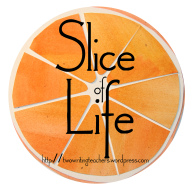(This is for the Slice of Life challenge for March, hosted by Two Writing Teachers. We are writing each day about the small moments in the larger perspective … or is that the larger perspective in the smaller moments? You write, too.)
 One of the more significant “shifts” in any version of Common Core-aligned curriculum in the upper grades (and maybe even some lower grades) is having students reach across varied texts and then synthesize what they have read in a piece of developed writing. I am trying to do more of that with my sixth graders, but still find the coordination of texts, graphic organizers and thoughtful writing components is a lot to ask of many of my students.
One of the more significant “shifts” in any version of Common Core-aligned curriculum in the upper grades (and maybe even some lower grades) is having students reach across varied texts and then synthesize what they have read in a piece of developed writing. I am trying to do more of that with my sixth graders, but still find the coordination of texts, graphic organizers and thoughtful writing components is a lot to ask of many of my students.
We did some work with this ‘reading across texts’ yesterday in class. It was one of those “teacher-led, think-aloud” days, where we worked together with the reading (the passages were about zoos and animals, so there was high interest by many), the annotated highlighting of passages, the breaking apart of the inquiry question (compare/contrast), building on graphic organization strategies from the whole year to adjust to more than one text, citing evidence from the three passages in a single piece of writing, and then talking through the writing piece.
It was fruitful but exhausting, in many ways, and some students still had that ‘deer in the headlights’ look in their eyes. We’ll be doing this more than a few times this year, of course, and normally I go deeper into multiple texts and synthesis writing later in spring as we move more into argumentative writing. But our state is moving some of the PARCC style components into our state test this month, and waiting for my curriculum map to catch up to us would be an injustice to students who likely will be confronted with these multiple-text questions (we saw some last year, too, but this year, the state has told us there will be PARCC components).
I’m not saying being able to read and comprehend, and write about, varied text is not a good skill to have. It is. I just know I, as teacher, need to keep learning more varied and better ways to teach it because even after what I think was some pretty decent teaching (if I do say so myself), I know it was not enough. And I have been thinking and working with this for quite some time now. I even led some PD with my colleagues a few years back.
But we always can learn more …
Peace (here, there, everywhere),
Kevin
I think, sometimes, that we are expecting kids to be adult readers. We think, “This is what I do as a reader, therefore they must learn to do it too!” and “we” forget that maybe they just need to read Harry Potter, and Wimpy Kid and graphic novels. It’s good of you to prep them for a difficult test. I don’t know. Maybe I’m just being a hippy. 🙂
It sounds like an amazing lesson, but I agree with you–it’s a lot to ask of kids whose frontal lobe is still developing! Our tests are becoming informational-text-heavy, too, which is great for future how-to projects and college text reading, but doesn’t lend itself to creativity and imagination and problem-solving. There needs to be some balance there.
While we remain weighed down by tests, Finland and Japan move ahead. Seems so simple but we remain anchored in the mud of the wrong vision.
http://www.npr.org/sections/ed/2016/03/10/469831485/americas-high-school-graduates-look-like-other-countries-high-school-dropouts?utm_campaign=storyshare&utm_source=facebook.com&utm_medium=social
… w/an imaginary hammer.